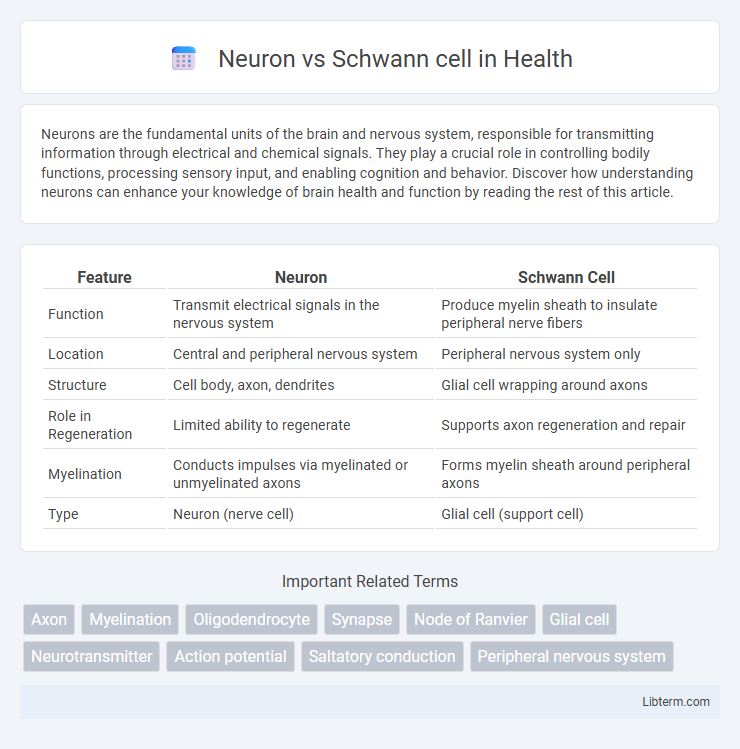Neurons are the fundamental units of the brain and nervous system, responsible for transmitting information through electrical and chemical signals. They play a crucial role in controlling bodily functions, processing sensory input, and enabling cognition and behavior. Discover how understanding neurons can enhance your knowledge of brain health and function by reading the rest of this article.
Table of Comparison
| Feature | Neuron | Schwann Cell |
|---|---|---|
| Function | Transmit electrical signals in the nervous system | Produce myelin sheath to insulate peripheral nerve fibers |
| Location | Central and peripheral nervous system | Peripheral nervous system only |
| Structure | Cell body, axon, dendrites | Glial cell wrapping around axons |
| Role in Regeneration | Limited ability to regenerate | Supports axon regeneration and repair |
| Myelination | Conducts impulses via myelinated or unmyelinated axons | Forms myelin sheath around peripheral axons |
| Type | Neuron (nerve cell) | Glial cell (support cell) |
Introduction to Neurons and Schwann Cells
Neurons are specialized cells responsible for transmitting electrical signals throughout the nervous system, playing a critical role in sensory input, motor control, and cognitive functions. Schwann cells are glial cells in the peripheral nervous system that provide myelination to axons, enhancing the speed and efficiency of nerve impulse conduction. Together, neurons and Schwann cells form a functional unit essential for rapid communication and neural protection in peripheral nerves.
Defining Neurons: Structure and Function
Neurons are specialized nerve cells responsible for transmitting electrical signals throughout the nervous system, featuring a unique structure composed of dendrites, a cell body (soma), and an axon. The dendrites receive incoming signals, while the axon propagates electrical impulses to other neurons, muscles, or glands, facilitating communication and response coordination. Unlike Schwann cells that form the myelin sheath to insulate axons in the peripheral nervous system, neurons generate and conduct nerve impulses essential for sensory input, motor control, and cognitive functions.
Understanding Schwann Cells: Key Roles
Schwann cells are essential glial cells in the peripheral nervous system responsible for myelinating axons, which speeds up electrical signal transmission and enhances neural communication efficiency. These cells also play a critical role in nerve regeneration by guiding axonal regrowth after injury and maintaining the extracellular environment. Unlike neurons, Schwann cells do not generate electrical impulses but provide crucial support for neuronal function and repair.
Origins and Development of Neurons vs Schwann Cells
Neurons originate from neuroectodermal stem cells in the neural tube during embryonic development, differentiating into diverse types responsible for signal transmission in the nervous system. Schwann cells arise from neural crest cells, which migrate along developing peripheral nerves and differentiate into myelinating or non-myelinating glial cells essential for peripheral nerve function. The distinct embryological origins of neurons and Schwann cells reflect their specialized roles in the central and peripheral nervous systems, respectively.
Morphological Differences: Neurons vs Schwann Cells
Neurons possess a large cell body with a prominent nucleus, dendrites for receiving signals, and a long axon for transmitting impulses, whereas Schwann cells are smaller, spindle-shaped glial cells that wrap around axons to form the myelin sheath. Neuron morphology includes specialized structures such as axon terminals and nodes of Ranvier, contrasting with Schwann cells' compact cytoplasm specialized for insulation and support. The morphological distinction reflects their functional roles, with neurons facilitating electrical signal transmission and Schwann cells providing myelination and nutrient support in the peripheral nervous system.
Functional Comparison: Signal Transmission and Support
Neurons are specialized for rapid signal transmission through electrical impulses along axons, enabling communication within the nervous system. Schwann cells provide critical support by forming myelin sheaths around peripheral neuron axons, which enhances signal speed and efficiency. Moreover, Schwann cells assist in nerve regeneration and maintain neuronal health by supplying metabolic support.
Neuron-Schawnn Cell Interactions in the Nervous System
Neuron-Schwann cell interactions are crucial for peripheral nerve function and regeneration. Schwann cells myelinate axons, enhancing electrical signal propagation and providing metabolic support to neurons. These glial cells also facilitate axonal repair by clearing debris and secreting neurotrophic factors that stimulate neuronal survival and regeneration.
Role in Myelination: Schwann Cells vs Neuronal Axons
Schwann cells are specialized glial cells responsible for the myelination of peripheral neuronal axons, enabling rapid saltatory conduction by forming the myelin sheath around axons. Neurons, specifically their axons, serve as the substrates for Schwann cell myelination, facilitating efficient electrical signal transmission along the nerve fibers. While Schwann cells actively produce and maintain the myelin sheath, neurons primarily provide the structural framework and metabolic signals necessary for Schwann cell function and myelin integrity.
Diseases and Disorders: Neuron vs Schwann Cell Involvement
Neurons are primarily involved in neurodegenerative diseases such as Alzheimer's, Parkinson's, and Amyotrophic Lateral Sclerosis (ALS), where neuronal death leads to impaired cognitive and motor functions. Schwann cells play a critical role in peripheral neuropathies, including Charcot-Marie-Tooth disease and Guillain-Barre syndrome, by affecting myelin sheath integrity and nerve signal conduction. Damage to Schwann cells results in demyelination, causing muscle weakness and sensory deficits distinct from the central nervous system pathologies associated with neuron loss.
Future Research Directions in Neuron and Schwann Cell Biology
Future research in neuron and Schwann cell biology is exploring advanced mechanisms of neuroregeneration and myelination to improve treatment strategies for neurodegenerative diseases and peripheral nerve injuries. Cutting-edge studies are investigating gene editing techniques and molecular signaling pathways that regulate Schwann cell plasticity and neuronal repair processes. Emerging technologies like single-cell RNA sequencing and in vivo imaging are driving deeper insights into neuron-Schwann cell interactions and their potential in regenerative medicine.
Neuron Infographic

 libterm.com
libterm.com